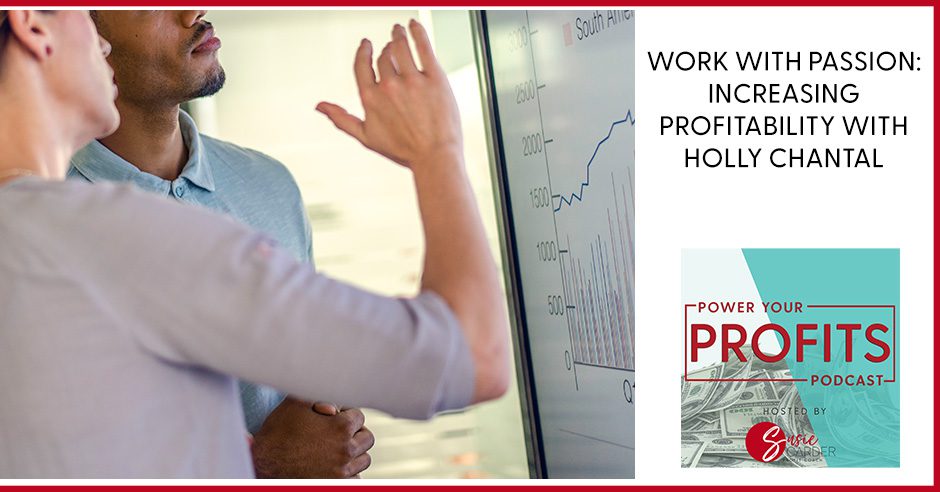
Building a brand is as challenging as growing one. Sometimes, even harder. We explore every way to take the business to the next level and be more profitable. What if there is a way for you to increase your revenue by 3x in 90 days? Listen in and learn as Holly Chantal talks about how you can do just that and more! She shares insights on how following your passion and narrowing your audience allows you to create specific offers or services and get your clients the best results while making sure you are getting as much fulfillment when providing them.
—
Our guest is Holly Chantal. She has been helping visionary, coaches, speakers, and service professionals enroll more clients into their high ticket offers by developing the business infrastructure they need to reach the next stage of growth. At 24, she started her career as a brand and business coach and hit six figures quickly. She had a hand in creating over 200 brands in coaching and service-based industries from crafting the brand messaging, authority positioning, strategic web designs, sales funnels, and copywriting. Some of her clients went on to build multimillion-dollar businesses. She has created $25,000 payday and five-figure webinars by shifting their business focus into areas they never thought would be possible, and never thought that people would buy. Please welcome my guest, Holly.
—
Holly, I am so excited that you’re here. More importantly, I am so excited that our students get to glean and learn from you. I read your bio and that’s awesome but what is your magic? What is that secret sauce that you do better than anybody else?
My magic is being able to see the details in addition to the big picture. A lot of entrepreneurs are visionary and a lot of my clients come to me with this vision for what they want even though they’re not sure how to get there or if it’s even possible. I’m good at locking in the details that can get them there. Oftentimes, that’s looking at what is it that they want to create, who are the people that they want to work with, and the services that they wish they were providing, but might not be right now because they’re afraid people aren’t going to buy. Dialing in those details of, “This is what you need to say. This is who you’re talking to, and this is what your magic is.” A lot of times, people can’t see their own magic, and that’s one of the details that I can dial in pretty quickly.
That’s juicy. Many people are challenged now with the reality of what’s happening in the world. What do you tell entrepreneurs about how do they stay in action? Business is business. It’s up and down. We might be going down. How do you help entrepreneurs inside of this, and keep them in action and growing?
Daily, we’re having challenges come up that aren’t necessarily our business, but just things that are going on in the world that are affecting us emotionally and mentally. It’s adding stress that we probably don’t need, and you have to stay in action. What I tell my clients is we create the plan and we work on the plan. We also need to be able to deal with their emotions, the stress, and the things that are going on because they don’t go away and they are distracting.
Being pretty empathic and intuitive, one of the things that I practice is if it’s not mine, I need to let it go. It doesn’t mean I can’t feel the feels and listen to what’s going on and react or respond. When it comes to my business, I need to have that separate time where if it’s not mine, I need to let it go now and focus on the actions that I need to take in order to reach my goals. The plans that you have for your business don’t need to go out the window when a curve ball is thrown your way or when it seems like the market is crashing and no one is buying.
On paper, the market isn’t doing great. However, it doesn’t mean people don’t still value your services. It does not mean that your goals are now suddenly out of reach. It might mean that you have to get clearer in demonstrating the value of your services. It might mean that you need to manage your money a little bit differently and pay attention to numbers that you might not have paid attention to before to make sure that everything is going to flow the way it needs to in order for you to keep moving forward.
I love that you teach people how to do it. I see it happen all the time. We’re not focusing on our ideal qualified client. You call it the target audience. People call them avatars. How do you help students find that target audience or their avatar or what I say is your ideal qualified client? What are some techniques that you can give us so that we can evaluate? I think you’re right. In the downtime, it’s like, “Am I marketing to fans or am I marketing to the client that I want?”
There are a couple of nuances there. Who are the ideal qualified clients who value your services the most, and are already looking as you’re leaning in? Also, who do you value working with the most? Who do you want to help? When I’m working with folks on their target audience, we create what I call target profiles, which other people might call avatars.
[bctt tweet=”When you can dial into what someone is experiencing and speak to them on that level, they will connect with your marketing in a completely different way. ” via=”no”]
What I find is for most coaches and consultants who I work with is within their marketing, they are trying to market to multiple different profiles, and they’re grouping them together. They’re using examples that are broad. In their copy, they are using bullets that are hitting all of the possibilities of what someone could be experiencing instead of focusing on who they want to attract. What we do is look at their target audience as a whole, and who are the different profiles that they would be talking to.
Different profiles might be people that are on different stages of their journey or people that are dealing with one specific challenge versus another specific challenge. We start to create these detailed descriptions of what’s going on in this person’s life. What have they already tried before? How is your service going to fit in? It’s detailed and tangible like, what is it going to do for them? Not make their life better. Not add six figures to the revenue. We’re talking about details like in their specific scenario, what is working that you’re going to do?
When you can do that, it allows you to dial in that value of your services, and describe it in a way that they feel seen and heard. They feel like you are so much clearer than anyone else they’ve talked to who is trying to sell them something. That’s something we’re always on guard of. It’s people selling to us. When you can dial into what someone is experiencing and speak to them on that level, they connect with your marketing in a completely different way.
I love that. The interesting thing is the last time we worked with you, we ended up with nine pages of that detail. We were pretty clear and they’re like, “No, we need it more granular.” I’m like, “How do we get more granular.” Nine pages later, it’s granular, which is juicy because you start thinking so much deeper. That’s looking at aligning your marketing decision-makers and process buyers through hiring you and going, “Is this person right for me? Are they not right for me?” Do you have some ways that you can help us get clear on that person? Are there questions that you ask? How do you get us to get clearer when having students buy from us?
There are a couple of top-level terms or phrases that help. A lot of times I will talk to someone and say, “Who do you work with? Who is your target audience?” They’ll respond with, “Anyone who,” instead of, “Someone who.” That term or phrase can help you add specificity to who you’re looking for. When you’re saying anyone who, you’re automatically going to talk generalities. When you say someone who, then you’re describing a scenario.
The other way to do it is if you’re thinking in your target audience, “I work with someone who is doing this or this,” or “They’re encountering this challenge or this challenge,” separate each of those. Anytime you’re saying “or” and adding different variations, that’s a different profile. If I’m working with someone who’s starting out in their business and they are having a hard time getting leads, finishing their website, or closing leads, you might say that but each of those is a different profile because each of them has a different set of problems, a different set of things they’re trying, and a different result that they want to create.
If you can do that, it easily allows you to take that broader audience and start segmenting it into categories that let you create specific offers, copy, and marketing messages for that person. It doesn’t mean you have to only talk to one of them like you’re only allowed to market to one of them. It means that in each piece of marketing you create like if you’re writing an article or you’re doing a podcast interview or you are writing a webinar, you are speaking one at a time. It helps you dial in your messaging and how you’re describing the offer in a way that they are going to recognize themselves and be able to visualize themselves getting the result because they can follow the steps. It’s all relevant to them.

You like to look at our businesses like a puzzle. I love your Mr. Potato Head analogy. Let’s talk about that analogy because it makes it so much easier to go, “I see what you see now.” How does that relate to marketing and working with clients?
If you go to my website and in some of my webinars, I talk about Mr. Potato Head. What we’re talking about is this visual of Mr. Potato Head but all the pieces are in the wrong place. This visual comes from many of my clients who come to me already having a lot of pieces. I work with people that are established further along in their business, and they want to double or triple the revenue without having to do anything more.
We can do that by dialing in your message. If you’ve been in business and you’re working with clients, chances are you already have everything we need in order to do that. It might be in the wrong places. When I say like it, I’m talking about the things that you’re spotlighting in your services or the reasons why people should be hiring you. It’s those target profiles we were talking about. It’s all in your head. If you were to be asked the right questions, you would be able to draw out what those magical combinations are.
Mr. Potato Head is like most people. They are starting with the wrong pieces, not realizing they have the pieces. Some pieces could be missing because you’ve never explored that before. The way I work is I ask the right questions to get all of those pieces out. We are pulling all the pieces out of Mr. Potato Head. We’re laying them out on a table where we can make decisions. What goes? What stays? What needs to be spotlighted over something else? What’s going to become the thing you’re known for versus what’s the skill or methodology that’s going to stay in your toolbox for the right moment, and all of those things?
We then reassemble Mr. Potato Head the way he’s supposed to be. Sometimes, there’s Mr. Potato Head and we also create little Baby Potato Heads that are like the sub-brands. It’s a different way of looking at how the messaging in your business is organized. When you have that clarity, it makes it that much easier to create your marketing.
How do you help your clients 3X their revenue? You say, “90 days, we can grow it three times.” That’s a huge promise. How do we help clients do that?
I have a pretty good track record of if someone is making at least $50,000 a year, that’s between $3,500 and $5,000 a month, we can triple that within 90 days. How we do that is simply by changing the way they’re talking about their offers. The assumption here is that if you’re doing $3,500 to $5,000 a month, you’re already having conversations with people that are interested in working with you. Whether they be from referrals or from your online marketing.
[bctt tweet=”When you have clarity, creating your marketing is much easier. ” via=”no”]
Ideally, if you have any audience, whether it be a Facebook group, your email list, or even your LinkedIn following, you have an audience that if we were to put more effective language in front of, you’re going to get more people raising their hands to work with you. The other thing I find is that in that income range, I find that a lot of people are undercharging for their services. They probably still have the same pricing that they did when they started or are very similar. We need to make sure that they’re charging an appropriate amount.
A lot of times that revenue jump is from charging an appropriate amount for their services, and then having the messaging to support it. We’re getting more people raising their hands. We’re charging more for the product or service. That’s resulting in probably not a lot more sales. We might be increasing sales by 50%. If you’re working with four clients at a time, now maybe you have six, but they’re working with you for 2-3 times as much, which is where that revenue jump comes from.
I find that people do that too like, “What does Holly charge? What does Susie charge? What does Bob charge? I’m going to charge this.” Who cares what they charge?
You’d be surprised what your potential is for yourself.
They’re like, “I didn’t know I could charge that.” My best lessons have been when I’ve not done it right or I’ve failed. I don’t like it. I don’t want to do it. I can talk about it after it and I won’t talk about it while I’m in it. You’ve been doing this for a long time. In growing your brand, what has been one of the biggest lessons that you’ve learned from either your failure or doing it wrong? What was that and what did you learn?
These in-the-spot examples always throw me because my brain goes, “There are all these things.” I’ve been in business for over ten years and there have been challenges. There are lessons learned. The biggest one that comes to mind is hedging my bets too much. When I started my business, I ran my business extremely intuitively. I was in my mid-20s. I was fresh out of school and I hadn’t failed yet. I’ve got six figures within my first eighteen months. I was killing it and on my way to seven figures by the time I was 30. Things were great, then I had kids.
That shook things up. This is that naivety of being in your twenties. I assumed I could still produce and work the same amount that I was. That wasn’t possible. You can’t do the same on four hours of sleep that you can do on your eight hours of sleep. It’s not possible. Let alone the fact that you have beings that you’re responsible for. That caused a lot of challenges and I stopped listening to myself because as I was shifting into my role as a parent, I question everything because I’m responsible for this being. I also started questioning my decisions in my business.

It took me a couple of years to realize that I had moved out of running my business by intuition. Instead, I was running it through fear and I was hedging everything. I was not willing to take risks because I was so afraid I was going to put all that energy into something that will not work out. That destroyed my confidence. It made me play a lot smaller than I could have been even with the reduced hours that I was able to work. I’ve learned this lesson a few times. Going all-in in the direction that you feel passionate about and letting yourself play full-out makes such a big difference.
Fast forward, I have three kids. I worked twenty hours a week. I am still producing the same revenue that I did back then. I’m doing it all because I’m running my business intuitively. I’m running my business. I’m following the dopamine and what I’m passionate about and what excites me rather than what the safe bet is. When you do that, it excites your audience. They want to follow you on that path. It’s a much more satisfying way to run your business.
It is. I’ve made some decisions and my team is like, “Why are we doing this?” I’m like, “It’s a gut thing. It may not make sense to you, but it makes sense to me and I’m doing it.” It has always worked out, whether it’s a risk or a different coach or a program that’s going to help me excel or have me look at my business differently. Sometimes it’s having a coach like you saying, “Let’s look at it this way.” That’s the value.
You’re going to pay for it one way or another. You’re going to pay someone to support you like, “Let’s shave ten years off your learning curve.” You have that ten years of experience. For somebody new, it’s like, “Don’t do it that way. Do it this way. This way is going to help us get to that goal faster.” That’s why I always say that the person you’re going to hire, you got to make sure that they have bloody knees and bloody elbows. They’re not teaching theory because a theory is different. You can smell that a mile away. You’re like, “That sh*t is not going to work.”
You have to follow those inklings too. You’re staying in your gut. A part of you knows when you’re hiring someone if it’s the right person for you or not. Another lesson is not listening to that intuition or that gut feeling when hiring someone and when taking on clients. There are clients that throw up those red flags but it’s like, “I need to pay the bills this month,” but if you say yes, it’s not worth it.
“All money is not good money. Back away.” I had that a couple of months ago. I like them but they’re chaos. I don’t want to work in chaos.
That’s my problem. I like people. When I do strategy and I’m meeting someone for the first time, I’m always excited about their business and what they’re doing. I like them. Sometimes I still have to say no because I know that our personalities don’t fit or there’s something that they need that I can’t provide because it’s not my job. It’s not what I do.
[bctt tweet=”You can’t do the same with four hours of sleep that you can do with eight hours of sleep.” via=”no”]
It’s not in your wheelhouse. That’s staying clear. I love that. One specific challenge is, “I’m good at this. What am I good at?” Do that, and then there’s money all around you. We all do that at the beginning of our careers. It’s like, “I could do that too and I could do that too. I don’t like to do that. I don’t want to do that.” Just because I can do it doesn’t mean there’s good money to be made.
Let’s shift a little bit because this is Power Your Profit. I love that you only work twenty hours a week and still produce the same result. I love that your family’s a priority and you boldly say that. In my generation, we were shamed if we were taking care of our kids or we could do it all and be all. You can’t do it all and be all. What have you done to build your own personal wealth? What are some strategies that you’ve done to build your wealth for your family and for yourself? Business is one. I use the money in my business to do other strategies. What have you done?
One of the things that I was fortunate enough to learn early on back in the first two years of my business was the Profit First methodology. It’s funny because I didn’t read the book until maybe a year or two ago, but someone explained the concept to me. I realized I hadn’t been paying myself in my business. I had my business money and that was it. I would deduct whatever I needed out of my account to pay my bills rather than paying myself and then allocating what needed to be allocated to the business.
That was a complete game changer for me in the beginning stages. Now, I’m saving up for my kids’ college. I’m investing in my own retirement and all of those things. If I hadn’t prioritized paying myself, it is so easy to keep the money in your business, keep reinvesting, and keep building better shinier things rather than also making sure that you’re taking care of your personal life, the future of your kids, and all those things. For me, that was one of the biggest turning points and the biggest lessons that I’ve used this entire time in business.
When you don’t pay yourself, you start resenting the business unconsciously.
It’s not just resentment. You feel like you’re failing because you’re bringing in so much money but if you’re not paying yourself, it’s like you’re not making any money. You feel like the business is constantly sucking your resources. I have trailblazers that I work with long-term, and this is one of the patterns I look for. Every 90 days, we take a look at where their revenue is. It’s like, “How much did you pay yourself this quarter?” We need to make sure that you’re paying yourself because when most business owners come to me, paying themselves isn’t the priority. Growing the business and reinvesting the business are the priorities, which are important to a point. At some point, you need to start paying yourself. It needs to be a profit. You shouldn’t be running your business like that for years at a time.
I have a client that we’re analyzing her business and she’s at $2 million now. I looked at how much she was paying herself. She’s paying herself $3,500 a month. I’m like, “You’re paying everybody else.”

It’s so common though.
“You’re paying your marketing person $10,000 a month. You’re paying this other person $12,000 a month. What are you doing?” If you were the least paid in your business, something is wrong with the model. Sometimes, you have to have somebody look inside and see that.
A lot of times, it’s even a woman or mother thing where we’re used to, “I can survive on this, so I’m going to do that.” We don’t take more than what we need to survive.
I’ve done it. I’ve done that. It’s the same with Profit First. I did that. At the end of the year, I’m like, “How did I lose money? This makes no sense,” because I didn’t have Profit First. I didn’t have that strategy in place. This was many years ago. I’m a little seasoned. I’ve been doing this for a little bit. Those are hard lessons. If you can get that now, I don’t care where your business is. If you look at my client, she’s doing $5 million in sales and only paying herself $3,500 a month. I’m like, “Something is wrong right with that. We don’t want that for you. We want you to be prosperous.”
The good thing is that’s usually a quick fix. Once you have that reframe and plan differently, it’s game-changing.
What do you want to be remembered for?
This is the thing that I want to be remembered for. I got into coaching because I saw a coach for the first time on stage. I used to work at a network marketing company and we were at a conference. The feeling that I had and the feeling that was in the room were like your dreams are possible. This was something that I had always known.
[bctt tweet=”If you’re not paying yourself, it’s like you’re not making any money, and it will feel like the business is just constantly sucking your resources.” via=”no”]
I’m fortunate to have very supportive parents. I always like assumed my dreams are possible. If I wanted it, I could have it. I just had to work for it. Did not realize that that was not the normal way of existing. Many people were compromising on what it is they wanted because they didn’t think that they could have it or that they deserved it or that it was possible for them. What I do and why I started doing what I do is I want to help people go after what they want, have their dreams, and have their cake and eat it too.
The way I do that is through those nuts and bolts of practically laying the foundations and your business strategy and growing your business. For entrepreneurs, our business is the key to achieving all those things that we want, having the financial and time freedom, and being able to follow our passions. We have such a huge opportunity. That’s what I enjoy doing and fulfilling. That’s what I would like to be remembered for.
I love that too. That’s a juicy one. I know that you come bearing gifts. What’s the gift that you would love for our students to have to support them in figuring out who their ideal qualified client is?
I have a PDF that will help you reframe the way you look at your marketing. It’s called the Buyers Arc. The Buyers Arc is the decision-making process that someone goes through when they’re looking to hire you or someone else. The Buyers Arc breaks down the five different stages of that decision-making process, and then what questions you need to be answering in your marketing, and what types of content those questions might be couched in.
Whether it be a blog post or webinars like what stages of the marketing funnel they’re in so that you can create this clean and easy marketing sequence that moves someone from becoming aware of you to buying within three days. I have people come to me, never having heard of me before, go on my website and end up buying an $ 18,000 package within 24 hours. It’s because my marketing is aligned with the Buyers Arc. They have everything they need to make the best decision for themselves.
We all need that and you’re being modest. It’s 25 pages. It’s not just a PDF. Sometimes you get stuff and you’re like, “Really? That was it?”
It’s like a mini eBook. It’s not quite like a book.
Twenty-five pages of getting clear, which I love. I love the resources and what you’re up to. I love that you took the time out of your crazy busy day to spend with us so that our students can drill deeper and have a better understanding. How do people find you, Holly, on social? Your website is your name, which is juicy.
HollyChantal.com. You can also find me on Facebook, Holly Chantal. I don’t know anyone else that has that name, so I’m pretty easy to find.
Thank you for being here and for everything that you do. I appreciate you. You’re going on holiday. Have a wonderful holiday and we look forward to chatting again.
Thank you for having me. I hope everyone has an awesome day.
 At the age of 24, I started my career as a Brand and Business Coach, and I hit six figures in revenue within 18 months.
At the age of 24, I started my career as a Brand and Business Coach, and I hit six figures in revenue within 18 months.
I’ve had a hand in creating over 200 brands within coaching and service based industries from crafting the brand message, authority positioning, strategic website design, sales funnels, and copy writing.
Some of my clients went on to become million dollar business owners, others have become nationally recognized experts, created $25k pay days, five figure webinars, and shifted their business focus into areas they never thought were possible because – “no one would buy that”.
COPYRIGHT © 2024 SUSIE CARDER | DESIGNED BY LUTZ MULTIMEDIA LLC